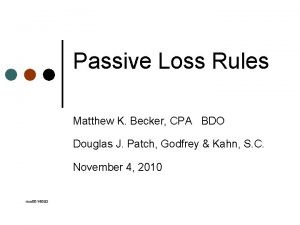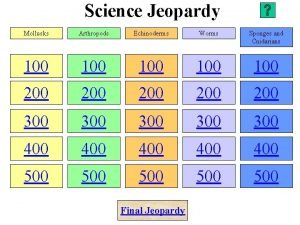Ch 4 2 Section Review Key CPA Chem















- Slides: 15

Ch 4 -2 Section Review Key CPA Chem

1. State the Periodic Law • When elements are arranged in order of increasing atomic number, there is a periodic repetition of their physical and chemical properties.

2. What do elements in the same period have in common? • Elements in the same period have valence electrons in the same energy levels as one another • Example: • all elements in period 2 have outer electrons that fill the 2 s and 2 p orbitals • all elements in period 5 have outer electrons that fill the 5 s, 5 d, and 5 p orbitals

3. What do elements in the same group have in common? • Same families/groups tend to have similar physical & chemical properties because they have similar electron configurations • Example: Li = [He] 2 s 1, Na = [Ne] 3 s 1 1 v. e. Cl = [Ne] 3 s 2 3 p 5, Br = [Ar] 4 s 2 3 d 10 4 p 5 7 v. e.

4. Why do groups among the main group elements display similar chemical behavior? It is because the electron configurations of the elements in each main group are regular and consistent: the elements in each group have the same number of valence electrons.

5. How do valence electron configurations of the alkali metals compare with each other? The alkali metals have a single valence electron (the electron configuration is ns 1), they are very reactive as they can easily lose one valence electron.

6. Why are the alkaline-earth metals less reactive than the alkali metals? • It is because the alkaline-earth metals have two valence electrons, and they must lose both their valence electrons to get to a stable electron configuration. • It takes more energy to lose two electrons than it takes to lose just the one electron that the alkali metals must give up to become stable.

7. In which groups of the periodic table do the transition metals belong? • The transition metals belong to group 3 -12.

1. What properties do the halogens have in common and why? Halogens are the most reactive group of nonmetal elements because they have seven electron valence electrons and only need to gain one more electron to get full electron shell. They also react with most metals to product salts because the alkali metals can donate one electron to halogens.

2. Why the nuclear structures of the actinides more important than the electron configurations of the actinides? • It is because the nuclei of actinides are unstable and spontaneously break apart, all actinides are radioactive.

3. What is an alloy? • Alloy is a solid or liquid mixture of two or more metals.

4. Why is hydrogen so unique than the other elements • It is because it only consists of just one proton and one electron, and it behaves unlike any other elements .

5. How was Moseley’s arrangement of the elements in the periodic table different from Mendeleev’s? Moseley’s periodic table used atomic number for arrangement of the elements. Mendeleev’s periodic table used atomic mass for the arrangement.

6. What property do noble gases share? How do the electron configurations of the noble gases give them this shared property? • Noble gases are unreactive because they have a full set of eight electrons and so they are very stable.

7. How do the electron configurations of the transition metals differ from those of metals in Groups 1 and 2? • Transition metals in each group of 13 -18 do not have identical outer electron configurations, but Group 1 and 2 have identical electron configurations (ns 1 and ns 2)
 Cpa chem
Cpa chem California cpa regulatory review course
California cpa regulatory review course Bdo
Bdo Becker and smith cpas performs a financial statement
Becker and smith cpas performs a financial statement Gen chem review for ochem
Gen chem review for ochem Ap chem equilibrium review
Ap chem equilibrium review Ap chem electrochemistry review
Ap chem electrochemistry review Chapter review motion part a vocabulary review answer key
Chapter review motion part a vocabulary review answer key Chapter 18 review chemical equilibrium
Chapter 18 review chemical equilibrium Evidence of evolution
Evidence of evolution Section 38-1 review echinoderms answer key
Section 38-1 review echinoderms answer key Section 19-1 understanding populations answer key
Section 19-1 understanding populations answer key Chapter 9 modern chemistry review answers
Chapter 9 modern chemistry review answers Examples of echinoderms
Examples of echinoderms Reaction rates and equilibrium worksheet answers chapter 19
Reaction rates and equilibrium worksheet answers chapter 19 Section 33-1 review porifera answer key
Section 33-1 review porifera answer key





























